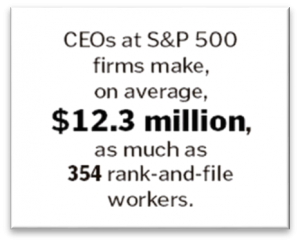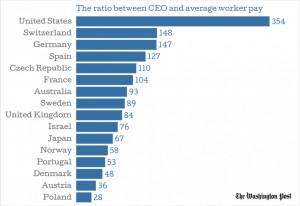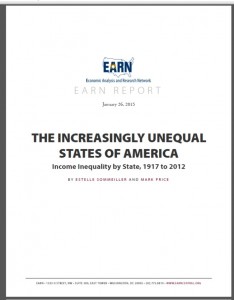As Income Inequality Grows Nationwide, CT's Top 1% Earn More Than in Any State
/Connecticut's top 1 percent earned an average of $2.7 million, compared to an average of $52,000 for the rest of the taxpayers -- a ratio of about 51 to 1, according to a report from the Economic Analysis and Research Network (EARN). The data indicate that the top 1 percent of taxpayers in Connecticut earn more than $677,608 — the highest 1-percent income threshold in the nation, according to the report issued earlier this year, based on 2012 data. In addition, Connecticut has the largest income gap between the top 1 percent of taxpayers and the bottom 99 percent, according to a recent study, and a AP-GfK poll found that 68 percent of Americans believe that wealthy households pay too little in federal taxes. It is little wonder that some describe the nation – as well as Connecticut – as separate and disparate lands. Income inequality drives the conversation.
 The top 1 percent in Connecticut saw incomes grow by 35 percent between 2009 and 2012, while the bottom 99 percent of Connecticut taxpayers saw average real income growth decline by 5.4 percent during the same period, according to the report. In fact, the states in which all income growth between 2009 and 2012 accrued to the top 1 percent include not only Connecticut, but Delaware, Florida, Missouri, South Carolina, North Carolina, Washington, Louisiana, California, Virginia, Pennsylvania, Idaho, Massachusetts, Colorado, New York, Rhode Island, and Nevada.
The top 1 percent in Connecticut saw incomes grow by 35 percent between 2009 and 2012, while the bottom 99 percent of Connecticut taxpayers saw average real income growth decline by 5.4 percent during the same period, according to the report. In fact, the states in which all income growth between 2009 and 2012 accrued to the top 1 percent include not only Connecticut, but Delaware, Florida, Missouri, South Carolina, North Carolina, Washington, Louisiana, California, Virginia, Pennsylvania, Idaho, Massachusetts, Colorado, New York, Rhode Island, and Nevada.
A recent article in the Boston Globe, Divided Nation, included the following:
- The nation’s 100 richest families have as much wealth as the 80 million families who make up the bottom 50 percent in wealth, according to the University of California, Berkeley.
- By the late 1970’s the wealth gap in America had substantially closed over the previous five decades, with the top .01 percent of Americans holding 7 percent of the nation’s wealth. The trend then reversed. By 2012, the top 0.1 percent controlled 22 percent of the nation’s wealth. Projections are the percentage will reach 25 percent by next year.
- An estimated 7 million families have lost their homes to foreclosure since 2007, according to Moody’s Analytics. And 6.5 million families still hold mortgages larger than the value of their home.

A study conducted at Harvard Business School last fall found that Americans believe CEOs make roughly 30 times what the average worker makes in the U.S., when in actuality they are making more than 350 times the average worker. A previous analysis estimated that it takes the typical worker at both McDonald's and Starbucks more than six months to earn what each company's CEO makes in a single hour.
The average Fortune 500 CEO in the United States makes more than $12 million per year, which is nearly five million dollars more than the amount for top CEOs in Switzerland, where the second highest paid CEOs live, more than twice that for those in Germany, where the third highest paid CEOs live, and more than twenty one times that for those in Poland, the Harvard report indicated.
 The wealth disparity is also on full display in politics, the Globe points out, noting that 100 super-wealth Americans accounted for 41 percent of contributions in 2012 to so-called Super Political Action Committees (PACs).
The wealth disparity is also on full display in politics, the Globe points out, noting that 100 super-wealth Americans accounted for 41 percent of contributions in 2012 to so-called Super Political Action Committees (PACs).
Widely reported estimates suggest that compensation of CEOs was about 20 times as much as the typical worker in the 1950s, rising to 42-to-1 in 1980 and 120-to-1 in 2000. In 2013, the ratio stood at 204-to-1 for the S&P 500, with the average of the top 100 companies at nearly 500-to-1, according to a 2013 Bloomberg Businessweek report cited a study by researchers at Rice University and the University of Houston last month, which found that for the vast majority of United States commercial banks, the ratio of CEO-to-employee pay was lower than at the top echelons of the S&P 500.
The EARN report concludes by starkly pointing out that “Policy choices and cultural forces have combined to put downward pressure on the wages and incomes of most Americans even as their productivity has risen. CEOs and financial-sector executives at the commanding heights of the private economy have raked in a rising share of the nation’s expanding economic pie, setting new norms for top incomes often emulated today by college presidents (as well as college football and basketball coaches), surgeons, lawyers, entertainers, and professional athletes.”





























